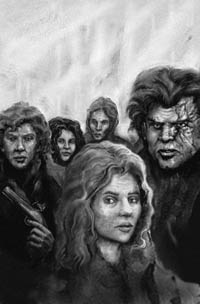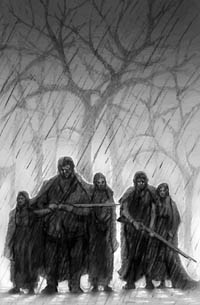Dark and Bloody Ground
Alan M. Clark digs into history and horror in The Door That Faced West
In his new novel, The Door That Faced West: An Early Western, author and illustrator Alan M. Clark takes readers on a voyage of discovery through a brutal and bloody history that is often hidden under our own feet. It’s a subject he learned about firsthand as a child growing up in the Oak Hill neighborhood of Nashville during the 1960s.
 “I was about ten when a neighbor across the street straightened a creek by digging a ditch through some higher ground,” Clark says. “I was exploring the ditch, looking for snakes or snapping turtles, when I found human bones sticking out of the banks. There were bits of leather and corroded brass with the bones so they were probably from the [Civil War’s] Battle of Nashville, which took place in that area. I felt like an archeologist or an explorer who had stumbled upon a deadly wilderness. It was exciting, and the experience gave me a sense of what had come before me. I was just one in a series of lives that had passed along that creek.”
“I was about ten when a neighbor across the street straightened a creek by digging a ditch through some higher ground,” Clark says. “I was exploring the ditch, looking for snakes or snapping turtles, when I found human bones sticking out of the banks. There were bits of leather and corroded brass with the bones so they were probably from the [Civil War’s] Battle of Nashville, which took place in that area. I felt like an archeologist or an explorer who had stumbled upon a deadly wilderness. It was exciting, and the experience gave me a sense of what had come before me. I was just one in a series of lives that had passed along that creek.”
The fact that a civilized world of suburbs and supermarkets was built on the blood and bones of past lives still holds a special fascination for Clark. “I like the dark and the disturbing, and that includes history,” he says. “Many years ago, a fellow horror writer and Tennessean, Jack Daves, told me about a book he loved, Spawn of Evil by Paul I. Wellman. It’s a history of many early-American criminals. Among them were the Harpe brothers, Wiley and Micajah.”
Often referred to as “America’s first serial killers,” the Harpes left a bloody trail through the early settlements of Tennessee and Kentucky during the final years of the eighteenth century. Their deeds make for fascinating, if gruesome, reading for any student of history, but it wasn’t their ruthlessness that drew Clark to their story.
 “The Harpes were bloodthirsty men that lived on the trail in the roughest possible existence,” Clark says. “And yet they were toting with them three women who cared about them and were so loyal to the Harpes that they once traveled more than a hundred miles through the wilderness to rejoin them after being separated. That seemed extraordinary to me.”
“The Harpes were bloodthirsty men that lived on the trail in the roughest possible existence,” Clark says. “And yet they were toting with them three women who cared about them and were so loyal to the Harpes that they once traveled more than a hundred miles through the wilderness to rejoin them after being separated. That seemed extraordinary to me.”
The Door That Faced West tells the story of a desperate flight west through the wilderness, but it is also a travelogue down the twisted path that runs from seemingly justifiable choices to horrifying consequences. The novel’s protagonist, Sadie Rice, flees from her brutal and abusive father. Only sixteen years old, Sadie joins her friend Bett Roberts and Bett’s older sister in a complicated relationship with two rough and mysterious frontiersmen who are soon revealed to be the horrible Harpes.
Although the Harpes’ monstrous actions are the driving force of the novel’s narrative, Clark focuses on the characters who allied themselves with monsters. “I don’t care about the mind of the serial killer,” Clark says. “I really don’t. I don’t know if understanding that is really possible, and, if we could, I think it would diminish its horrific value. Horror is about fear of the unknown and loss of control. So if you want that feeling, it needs to be from the victim’s point of view. Sadie is a victim of the Harpes, but she also benefits from what the Harpes have to offer her. She faces irreconcilable emotions—she’s horrified by what they do, but she also loves and feels loyalty to them for the protection they provide in a terrifying environment. That creates a moral ambiguity that haunts her, and it’s that haunting that gives weight to her story.”
 For Clark, the key to exploring such conflict is best served by the parameters of historical fiction. “Within historical fiction you have to remain true to the environment and mindset of people from that time,” he says. “It’s a tighter box that you have to fit yourself into as a writer. I like those constraints because I have a very wild imagination, and it can go out of control if I have free reign. So I have always developed constraints. I still play with the really bizarre, but I try to create within a set environment.”
For Clark, the key to exploring such conflict is best served by the parameters of historical fiction. “Within historical fiction you have to remain true to the environment and mindset of people from that time,” he says. “It’s a tighter box that you have to fit yourself into as a writer. I like those constraints because I have a very wild imagination, and it can go out of control if I have free reign. So I have always developed constraints. I still play with the really bizarre, but I try to create within a set environment.”
Clark’s bizarre imagination has served him well in his art career. A World Fantasy award-winning illustrator, Clark’s artwork has appeared in over 400 books and numerous magazines. A native of Nashville, Clark graduated from the San Francisco Art Institute and returned home, where he began building his career as a professional illustrator, developing a unique style that combined fine art sensibilities with traditional illustration techniques. In 1997, he relocated to Eugene, Oregon, where he has continued his career.
The same sense of discovery and exploration that led Clark to a muddy ditch at the age of ten still drives him in all his work—whether it’s exploring through his artwork the dark and fantastic worlds of writers like Stephen King and Ray Bradbury, or digging into the pages of history for his own writing. “People are built of their time and circumstances,” he says. “The people of past eras had the same emotions as we do today, but their thinking could be very different. For me, exploring that mindset is as exciting as any alien landscape.”


